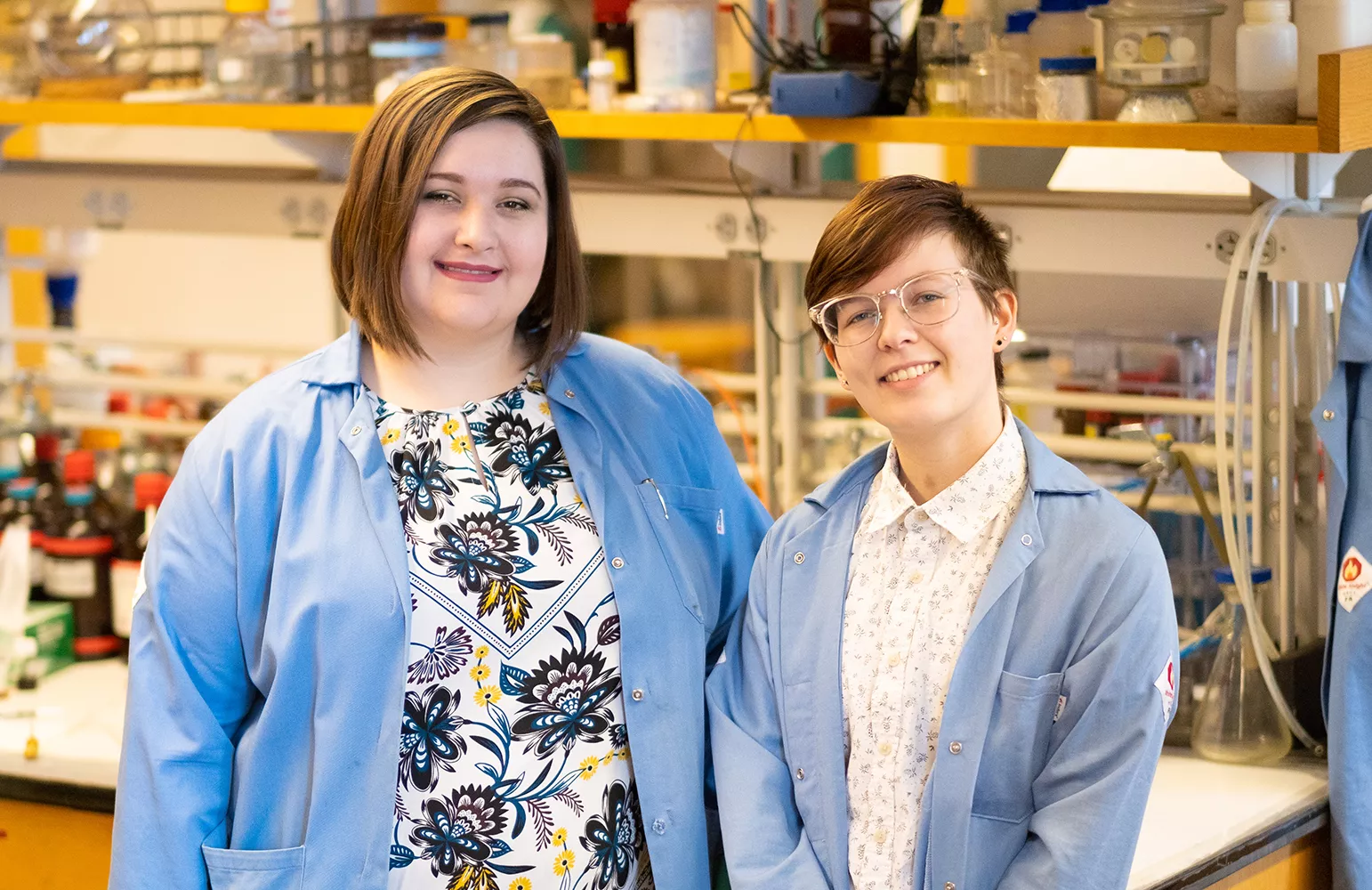
Graduate Students Cassandra Gates (left) and Emma Allen were among the Bryn Mawr students scheduled to give a poster presentation at the now-canceled National Meeting of the American Chemical Society.
While they're unable to present at the meeting, we wanted to share their abstracts and congratulate them on their achievements. Both students work in the lab of Professor of Chemistry Sharon Burgmayer.
From Cassandra Gates: Protonation-induced redox reactivity in synthetic models of the mononuclear molybdenum cofactor
Molybdenum-dependent enzymes are present in almost every living organism and crucial for sustaining life. These enzymes complete oxygen atom transfers on a variety of substrates by utilizing a molybdenum cofactor (Moco) composed of a molybdenum metal center coordinated by one or two pyranopterin dithiolene ligands (MPT) conserved across all molybdoenzymes. A total of eight electron redox equivalents occurs between the Mo metal center and MPT, making Moco one of the most redox rich cofactors in all of biology. Due to the instability of Moco outside of the protein matrix, there is still little known about the contributions of MPT to catalytic function. It is clear, however, that without MPT, the enzyme loses all catalytic activity. In order to reveal the role of the MPT ligand in catalytic function, the Burgmayer lab has developed a family of synthetic models with the structure [TEA][Tp*Mo(X)(S2C2(pterin)(-C(CH3)2R)], where TEA is tetraethylammonium, Tp* is tris(3,5-dimethylpyrazolyl)hydroborate, X is either O or S, and R is either hydroxyl or methyl.
Recent studies utilize these synthetic models to investigate the reactivity of the pyranopterin upon protonation in the pyrazine ring. The protonated Mo-pterin-dithiolene model is redox reactive and readily participates in coupled proton-electron transfer with a variety of substrates, including dichlorophenolindophenol (DCIP) and the biologically relevant redox cofactor flavin adenine dinucleotide (FAD). Preliminary investigations into the reactivity of the model system with known Mo-enzyme substrates, including dimethyl sulfoxide (DMSO) and nitrate, indicate that protonation may be sufficient to induce substrate reduction. The reactivity of this model system provides insight into the possible role of active-site hydrogen bonds to the pterin in enzymatic catalysis. The synthesis of this protonated species, its reaction chemistry and our conclusions regarding the electronic structure changes resulting from pterin protonation will be described. Experimental results include reactions monitored using UV-Vis Spectroscopy, various forms of NMR, FT-IR, ESI-mass spectrometry, cyclic voltammetry, and GC-mass spectrometry.
From Emma Allen: Making a Model for the Molybdenum Cofactor and Investigating Its Reaction Chemistry
Molybdenum (Mo) enzymes are required by almost every form of life and can be traced back to the first organism, the ‘last universal common ancestor’, or LUCA. Mo enzymes have been linked to multiple human diseases, proper plant development, and is crucial to the global cycling of the elements nitrogen and sulfur. The molybdenum cofactor (Moco), composed of a molybdenum metal center and one or two pterin-dithiolene ligands, is the name of the active site in all molybdenum enzymes. Because Moco is unstable without its protein blanket, information about the role of the unusual pterin-dithiolene chelate is largely not available. To obtain some information regarding the chemical behavior of Mo bound to a pterin-dithiolene, the Burgmayer lab has synthesized a model system similar in structure to the biological Moco in order to explore the importance of the pterin, which is believed to play a role in the redox chemistry conducted by the cofactor. The work to be presented includes a description of the general synthesis of the pterin-dithiolene model system as well as two current investigations. The target model system is generally described as [TEA][Tp*Mo(X)(S2C2(pterin)(-C(CH3)2R)], where TEA is tetraethylammonium, Tp* is tris(3,5-dimethylpyrazolyl)hydroborate, X is either O or S, and R can be hydroxyl, methyl or methoxy. Current work is directed at developing the reaction chemistry of the model complex where R = OH which has previously been shown to undergo a reversible pyran cyclization. The first investigation studies the reactivity of the pyranopterin-dithiolene Mo complex upon protonation in the pyrazine ring. The protonated Mo-pterin-dithiolene model is redox reactive and readily participates in coupled proton-electron transfer with a variety of substrates. The second investigation explores the outcome of reacting the pyranopterin-dithiolene Mo complex with (PPh3I)+I- where initial spectroscopic results indicate a significant change in the electronic structure of the pterin-dithiolene.
Graduate Education in a Liberal Arts Environment
Graduate education at Bryn Mawr was part of the founding mission of the College. Established in 1885, Bryn Mawr College takes pride in being the first institution in the U.S. to provide women a graduate education culminating in a Ph.D. Since 1931, graduate enrollment has been co-educational and today embraces inclusivity as one of its core values. Students in Graduate School of Arts and Sciences pursue research in graduate programs of international reputation.